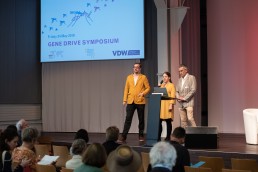News
Gene drives regulated for the first time in genetic engineering law
On June 7, 2019, the Federal Council spoke out in favour of tightening the safety requirements for laboratory experiments with gene drive organisms (GDO) in the Genetic Engineering Safety Ordinance. In addition, it also demands the development of GDO-specific safety measures and calls on the German government to give special weight to nature conservation.
Mosquitoes, flies and mice, but also plants can be modified by a new genetic engineering method called gene drive in such a way that they quickly and comprehensively spread a new trait and in wild populations. Through a special application of the so-called CRISPR-Cas technology, the genetic manipulation itself can be passed on and thus trigger a genetic chain reaction in nature that cannot be controlled in time or space. By releasing such gene drive organisms, entire populations or species in nature are to be genetically modified or even eradicated. Experiments with gene drive organisms in the laboratory involve the risk of experimental animals escaping. Even a few released GDOs could theoretically lead to the extinction of a species in nature.
After an alliance of NGOs (the AbL, BUND, GeN, IG-Saatgut, Testbiotech and Save Our Seeds) drew attention to this danger in an open letter, the federal states responsible for genetic engineering safety became active. At the plenary session of the Federal Council on June 7, 2019, the federal states responsible for the supervision of genetic engineering decided to set a safety level 3 (out of a possible four; the second more serious risk classification) for laboratory experiments with gene drive organisms for precautionary reasons. In an amendment to the Genetic Engineering Safety Ordinance, the federal government included GDOs in the ordinance for the first time and only provided for safety level 2 for laboratory experiments. In addition to this amendment, the federal states appealed to the federal government "to give special weight to the objects of protection under § 1 No. 1 of the Gene Technology Act and in particular to nature conservation in the future design of the specifications for the risk assessment and safety classification of gene drive organisms, over and above the regulations on gene drive organisms laid down in the Ordinance for the Reorganisation of the Law on Safety Levels and Safety Measures for Gene Technology Work in Gene Technology Facilities, taking into account the precautionary principle".
Following the Federal Council’s decision, the Genetic Engineering Safety Ordinance has become operative and includes gene drive organisms in the regulation of genetic engineering law for the first time.
However, there is also a catch: after the automatic classification of gene drive organisms in safety level 3, the Central Commission carries out a case-by-case assessment for Biological Safety (ZKBS). Based on this assessment, the ZKBS can select a different safety level, including safety level 1, which assumes that the risk to the environment and human health posed by the explored GMOs is negligible and therefore does not require any special safety requirements.
For this reason, the Federal Council's welcome decision was only the first, urgently required step. Since the Genetic Engineering Safety Ordinance is not yet designed to cover the risks posed by genetically modified organisms to biodiversity and the environment, the ZKBS and the federal states should draw up specific safety measures for this new class of genetically modified organisms as quickly as possible. In addition, the expert position on nature conservation issues within the ZKBS, which has been vacant for years, must now be filled quickly. We can no longer continue to perform safety classification and risk assessment of gene drive organisms without giving special weight to nature conservation.
Gene Drive Symposium in Bern - Wiping out unwanted species with CRISPR-Cas?

Gene Drive Symposium in Bern - Wiping out unwanted species with CRISPR-Cas?
An interdisciplinary gene drive symposium was held in Bern on May 24, 2019. A report was published highlighting scientific, ecological, social, ethical and regulatory issues related to the gene drive technology.
What is a gene drive?
CRISPR-Cas makes it possible: Gene drives are a genetic engineering process that is used, among other things, with the genetic engineering tool CRISPR-Cas to spread certain traits – such as infertility – quickly and permanently in wild animal and plant populations. The release of such gene-drive organisms is intended to genetically modify or even eradicate entire populations or species in nature. The Gene Drive Symposium in Bern discussed possible applications, social, ethical and ecological consequences as well as regulatory conditions for the use of this technology, which has so far only been tested in the laboratory. The gene drive report published there summarizes the findings.

How does a gene drive work?
CRISPR-Cas is a genetic engineering tool that can search for specific DNA sequences in the genome and break the DNA strands at these points. Genetic engineers make use of the cell’s own repair mechanisms for genetic manipulation: To create a gene drive, the genetic material for CRISPR-Cas is made available to the cell as a repair template. The cell copies this gene sequence into the fracture site and binds the broken DNA. Since the genetic engineering tool itself is thus present in an active form in the genome of the organism, it can become active each time the organism reproduces and copy itself into the genome of the reproductive partner’s gamete. In this way, almost all descendants of a gene drive organism inherit the gene drive and the trait that thus becomes widespread.
Fields of application
The largest field of application for GDO (gene drive organisms) in the future could be agriculture. US researchers and farming associations in particular hope that this technology will be able to decimate insects such as the cherry vinegar fly, aphids and the meal beetle. Overcoming herbicide and pesticide resistance in yield-reducing weeds or insects is also on the wish list of future commercial uses. Gene drives could also be used as biological weapons against plants, animals and humans. For this reason, the US Military Research Institute (DARPA) is one of the largest financiers of gene drive research.
The use of gene drives in malaria-transmitting mosquitoes is the most advanced project and, according to the project team of Target Malaria, will be ready for outdoor testing within five to ten years. Target Malaria, funded by the Bill and Melinda Gates Foundation, aims to eradicate the Anopheles mosquito in Burkina Faso or to genetically modify the mosquito to stop the transmission of malaria.
The nature conservation organisation Island Conservation, on the other hand, hopes to use gene drive organisms to combat invasive rodents that have been introduced into island ecosystems and threaten their biodiversity. For this reason, the idea of using gene drive organisms for nature conservation has been the subject of controversial discussion within the World Conservation Union (IUCN) for several years.
Open ecological, social and ethical questions
Gene drives turns nature into a genetic engineering laboratory. If the gene drive organisms created in the laboratory, for example mosquitoes, flies or mice, are released into nature, they set off a genetic engineering chain reaction that is currently neither spatially nor temporally limited. The result would be a global spread of the new genetically modified organisms. The transformation of the genetic engineering tool CRISPR-Cas, which is prone to mutations and errors, in wild populations is scarcely predictable. Unintended ecological consequences of emerging resistance and mutations, outcrossing into related species or unexpected effects on non-target species would probably be irreversible. Disturbances in the animal food chains and the resulting negative consequences for human food security could not be ruled out. It is questionable whether released gene drive organisms could be retrieved, or whether the ecosystems changed as a result could ever be restored to their original state.
There are also concerns from ethical and social perspectives: Should we presume to override the evolutionary rules of nature so fundamentally? Can such an invasive, totalitarian and disruptive technology, which has been based on patent claims from the beginning, even be adequately controlled? Is such a technology controllable? Which existing alternatives or potential less risky and more democratic solutions will be neglected or not developed at all if billions are currently invested in this high-risk technology?
SOS campaign for a global gene drive moratorium
For Save Our Seeds, gene drives are the most dangerous application of genetic engineering in the environment to date. That is why Save Our Seeds and hundreds of other civil society organizations are calling for a worldwide moratorium on the release of gene drive organisms into the wild. Save Our Seeds wants to spark broad, critical discussion about this technology in society and politics and to win over decision-makers and scientists at national, European and global level to stop the application of this technology before the first specimens are released into the wild. At the same time, SOS promotes respectful treatment of nature that preserves biodiversity and makes it available for human use – instead of exterminating individual species or manipulating them in such a totalitarian way for short-term purposes.
If you would like to support this cause, you can sign the petition for a global gene drive moratorium here.
More detailed information on gene drives from a scientific, ecological, social, ethical and regulatory perspective can be found in the Gene Drive Report published by ENSSER, VDW and CSS at the Gene Drive Symposium in Bern.
At the Gene Drive Symposium on May 24, 2019 in Bern, gene drive developer Kevin Esvelt from MIT in Boston and Ignacio Chapela, Professor of Microbial Ecology at the University of California at Berkeley and Ernst-Ulrich von Weizsäcker discussed possible applications, technical and ecological risks as well as social consequences of the gene drive technology.
Further video recordings of discussions and contributions to the symposium can be found at www.genedrives.ch
Parties in favor of a gene drive moratorium
In the forefront of the European elections, the SPD, Die LINKE and Die Grünen are calling for a gene drive moratorium. The CDU wants to examine the necessity of a moratorium.
In a poll of the top candidates for the European elections on their attitudes towards new genetic engineering and gene drives, the majority of the major German parties are concerned about the risks that could result from the release of gene drive organisms into nature.
The SPD considers a release of gene drive organisms to be "not compatible with the principles and objectives of the Convention on Biological Diversity".
The CDU/CSU points to "considerable risks" posed by transgenic gene drive organisms, particularly with regard to the potential to spread.
In its response, the Left Party emphasised the difficulty of risk assessment and the lack of retrieval options.
Bündnis90/Die Grünen write that it is "not responsible to release genetically modified populations with such a depth of intervention into the environment". The consequences cannot be estimated and a sensible fight against diseases must not change entire ecosystems. A release would be "uncontrollable and irreversible".
Regarding the requested gene drive moratorium the parties write:
CDU/CSU: "In the EU, there are no applications for field trials with organisms that have been modified using gene drives. There are also no known plans in this direction. Nevertheless, the CDU and CSU are in favor of additional regulations or even the necessity of a moratorium being examined".
SPD: "We advocate an international moratorium on gene drives because of the lack of knowledge, data and understanding with regard to their potential impact on biodiversity".
Bündnis90/Die Grünen: "We advocate a worldwide moratorium on the use of gene drives. This is necessary to comply with the precautionary principle and protect ecosystems."
DIE LINKE: "DIE LINKE therefore advocates an immediate moratorium against the release of GMOs in general and GMOs with gene drives in particular".
Unfortunately, the FDP did not answer our question.
Biodiversity convention fails in regulating new genetic engineering
At the conference of the UN Convention on Biological Diversity on November 29, 2018, 196 nations unfortunately only agreed to the lowest conceivable common denominator with regard to the research and release of so-called gene drive organisms. Instead of clear precautions and global control, the joint declaration contains only broadly interpretable, general appeals to governments.
"This means that the million-dollar lobbying of the Bill & Melinda Gates Foundation and the interest groups representing genetic engineering has largely prevailed," criticises Mareike Imken of Save Our Seeds. "This decision must become the beginning of a global campaign for a moratorium on this high-risk technology".
Instead of adopting a moratorium on the release of gene drive organisms, as demanded by over 200 civil society organisations and some governments, the resolution now adopted is limited to an almost arbitrary appeal for precautionary measures regarding the release of gene drives into the environment. It offers governments and scientists the opportunity to design research and releases according to their own definition of the appropriateness of precautionary measures, risk assessment and the involvement of local and indigenous groups.
Thus, the only international forum for regulating global threats to biodiversity and the transboundary handling of genetically modified organisms has blatantly failed in regulating the most dangerous use of genetic engineering in the environment to date. The consideration and involvement of "potentially affected" local and indigenous communities as called for by the CBD is to be welcomed. But the prior informed consent required only for these groups would first have to be made binding for all affected nations.
Gene drive organisms contain the programming for a genetic modification, which they pass on to all descendants in order to set off a genetic chain reaction in the environment. So far, there is no know way to apply any spatial or temporal restrictions and control. Spreading gene drive organisms globally will thus affect the entire human race. The use of this technology in nature therefore requires a consensus of the world community.
Save Our Seeds takes the decision of the CBD as an opportunity to launch a campaign with the aim of establishing a binding worldwide moratorium on the release of gene drives at the next CBD conference in Beijing in 2020.
Link to the decision of the CBD:
https://www.cbd.int/doc/c/2c62/5569/004e9c7a6b2a00641c3af0eb/cop-14-l-31-en.pdf
Call for a global moratorium on gene drives
Gene drives could change the world. If what is currently being developed and tested in various genetic engineering laboratories around the world actually works, this technology could be used to create organisms that are genetically manipulated in such a way that they can change their entire species, or even eradicate it. Together with 200 initial signatories, Save Our Seeds is calling for a moratorium on this technology.
A ghastly new form of genetic engineering: it is not individual strains of organisms that are modified and then prevented from passing on their genetic engineering properties to natural relatives to the greatest possible extent, but entire populations in nature become the object of genetic engineering. Gene drive organisms inherit 100 percent of their new properties, including a genetic engineering search mechanism that will also be used to manipulate the genome of subsequent generations.
We believe that this must be stopped before it is too late and therefore, on World Food Day, we launched an international appeal for a moratorium on gene drives in Berlin and Rome, together with the ETC Group, the Heinrich Böll Foundation and over 200 other first signatories.
Joint press release in German
The appeal in English
ETC Group study on Gene Drives in agriculture



